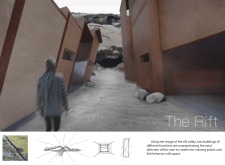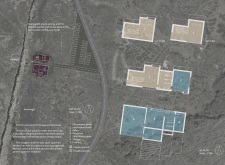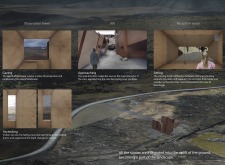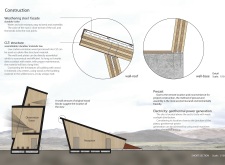5 key facts about this project
Functionally, "The Rift" serves multiple purposes, functioning as a visitor center dedicated to enhancing the experience of the surrounding rift valleys. It includes spaces for observation, reception, and a café, all tailored to engage visitors with the spectacular landscape. The layout is intentionally designed to create a flow between these areas, guiding people through the experience and fostering a sense of exploration. The observation tower stands out as a focal element, offering panoramic views that encourage visitors to connect with the surrounding geological formations. This structure not only serves a practical purpose but also becomes an integral part of the landscape, both visually and experientially.
The architectural design utilizes a carefully selected material palette that reflects the local context and ensures sustainability. Weathering steel is employed for the façade, chosen for its durability and ability to withstand the harsh Icelandic climate. Its earthy tones complement the natural surroundings, allowing the building to resonate with the colors and textures of its environment. Cross-laminated timber (CLT) is used for the structural framework, a choice that underlines the project’s sustainability goals while providing efficiency in construction. Precast concrete rounds out the material selection by providing a solid foundation, ensuring that the structures can endure the demands of the setting. These materials work together to create a cohesive and robust architectural language that embodies both resilience and integration.
One of the unique design approaches taken in "The Rift" is the emphasis on the relationship between the buildings and the landscape. The axial alignment of the two main structures recalls the geological formations of rift valleys, rooting the project in its natural context. As visitors approach the buildings, they are drawn toward the natural features that define the site, creating a dialogue between architecture and nature. The spatial organization further enhances this relationship by encouraging movement and interaction, with each space carefully articulated to provide distinct experiences. The reception area, for instance, features varied seating arrangements that allow for both intimate gatherings and larger group interactions, promoting a sense of community among visitors.
Overall, "The Rift" exemplifies a thoughtful approach to architecture that balances functionality with a deep respect for the environment. It invites exploration and engagement, drawing on the natural beauty of Iceland while offering a practical space for visitors. The careful consideration of materials and spatial relationships highlights the potential for architecture to connect people with their surroundings in meaningful ways. For those interested in a deeper understanding of this project, exploring the architectural plans, sections, and design ideas will provide further insight into the innovative approaches that define "The Rift."


























